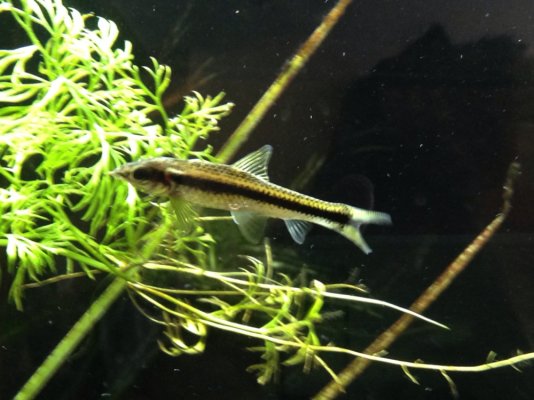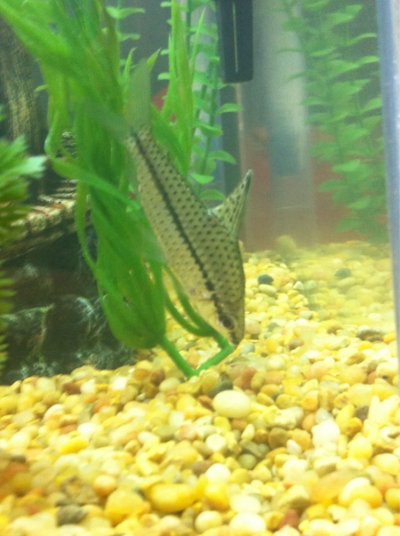You are using an out of date browser. It may not display this or other websites correctly.
You should upgrade or use an alternative browser.
You should upgrade or use an alternative browser.
What kind of fish I it?
- Thread starter makos
- Start date
The friendliest place on the web for anyone with an interest in aquariums or fish keeping!
If you have answers, please help by responding to the unanswered posts.
If you have answers, please help by responding to the unanswered posts.
foxyhasswag
Aquarium Advice Freak
Sienese algae eater yes it's safe what size tank
Bichir Bro
Aquarium Advice Addict
- Joined
- Aug 7, 2013
- Messages
- 1,773
Nope not a SAE, it's some specie of Headstander but i do not know which one!Sienese algae eater yes it's safe what size tank
Khuligirl93
Aquarium Advice Addict
- Joined
- Apr 13, 2013
- Messages
- 1,945
This is what my Siamese algae eater looks like: 
Doesn't look very similar IMO.
Yours looks like this headstander species
http://www.seriouslyfish.com/species/chilodus-punctatus/
Just type the scientific name into google and you'll get a lot more info

Doesn't look very similar IMO.
Yours looks like this headstander species
http://www.seriouslyfish.com/species/chilodus-punctatus/
Just type the scientific name into google and you'll get a lot more info
Sk3lly
Aquarium Advice Addict
How many mollies and platys?
Bichir Bro
Aquarium Advice Addict
- Joined
- Aug 7, 2013
- Messages
- 1,773
It is not a flying fox, it is not a SAE, it is a Spotted Headstander (Chilodus Punctatus).
It is Chilodus gracilis, sometimes called the Black line headstander, which grows to about 3-1/2 inches.
A 10g tank is not suitable for Molly's as they grow too large and have heavy bio-loads. Headstanders also are not suitable for such a small tank along with the fact they are very sensitive to water parameters so doing large weekly WC's to keep toxins and nutrient levels low are mandatory.
Usually the fish in the shops are sold as the Spotted headstander (Chilodus punctatus) but this fish is the similar looking Chilodus gracilis, sometimes called the Black line headstander. The biggest difference between the two is the prominence of a dark band running along the middle of the fish, which in C. gracilis is always present, but comes and goes on C. punctatus and is most obvious during breeding behaviour
A 10g tank is not suitable for Molly's as they grow too large and have heavy bio-loads. Headstanders also are not suitable for such a small tank along with the fact they are very sensitive to water parameters so doing large weekly WC's to keep toxins and nutrient levels low are mandatory.
Usually the fish in the shops are sold as the Spotted headstander (Chilodus punctatus) but this fish is the similar looking Chilodus gracilis, sometimes called the Black line headstander. The biggest difference between the two is the prominence of a dark band running along the middle of the fish, which in C. gracilis is always present, but comes and goes on C. punctatus and is most obvious during breeding behaviour
Last edited:
It is Chilodus gracilis, sometimes called the Black line headstander, which grows to about 3-1/2 inches.
A 10g tank is not suitable for Molly's as they grow too large and have heavy bio-loads. Headstanders also are not suitable for such a small tank along with the fact they are very sensitive to water parameters so doing large weekly WC's to keep toxins and nutrient levels low are mandatory.
Usually the fish in the shops are sold as the Spotted headstander (Chilodus punctatus) but this fish is the similar looking Chilodus gracilis, sometimes called the Black line headstander. The biggest difference between the two is the prominence of a dark band running along the middle of the fish, which in C. gracilis is always present, but comes and goes on C. punctatus and is most obvious during breeding behaviour
Thank you
pip walters
Aquarium Advice FINatic
You can read the article here, very interesting.
How to keep headstanders in the aquarium | Features | Practical Fishkeeping
It is also polite to reference a writers work when passages are copied word for word.
How to keep headstanders in the aquarium | Features | Practical Fishkeeping
It is also polite to reference a writers work when passages are copied word for word.
pip walters
Aquarium Advice FINatic
K sorry I didn't try to be rude
Not you my friend
Similar threads
- Replies
- 5
- Views
- 389
- Replies
- 1
- Views
- 134
- Replies
- 7
- Views
- 421
- Replies
- 1
- Views
- 368
Latest posts
-
-
-
Nitrates up, pH and total alkalinity down
- Latest: Airborne 82nd
-
-
-

